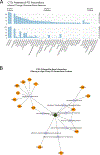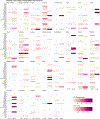Epidemiology meets toxicogenomics: Mining toxicologic evidence in support of an untargeted analysis of pesticides exposure and Parkinson's disease
- PMID: 36395557
- PMCID: PMC9897493
- DOI: 10.1016/j.envint.2022.107613
Epidemiology meets toxicogenomics: Mining toxicologic evidence in support of an untargeted analysis of pesticides exposure and Parkinson's disease
Abstract
Background: Pesticides have been widely used in agriculture for more than half a century. However, with thousands currently in use, most have not been adequately assessed for influence Parkinson's disease (PD).
Objectives: Here we aimed to assess biologic plausibility of 70 pesticides implicated with PD through an agnostic pesticide-wide association study using a data mining approach linking toxicology and toxicogenomics databases.
Methods: We linked the 70 targeted pesticides to quantitative high-throughput screening assay findings from the Toxicology in the 21st Century (Tox21) program and pesticide-related genetic/disease information with the Comparative Toxicogenomics Database (CTD). We used the CTD to determine networks of genes each pesticide has been linked to and assess enrichment of relevant gene ontology (GO) annotations. With Tox21, we evaluated pesticide induced activity on a series of 43 nuclear receptor and stress response assays and two cytotoxicity assays.
Results: Overall, 59 % of the 70 pesticides had chemical-gene networks including at least one PD gene/gene product. In total, 41 % of the pesticides had chemical-gene networks enriched for ≥ 1 high-priority PD GO terms. For instance, 23 pesticides had chemical-gene networks enriched for response to oxidative stress, 21 for regulation of neuron death, and twelve for autophagy, including copper sulfate, endosulfan and chlorpyrifos. Of the pesticides tested against the Tox21 assays, 79 % showed activity on ≥ 1 assay and 11 were toxic to the two human cell lines. The set of PD-associated pesticides showed more activity than expected on assays testing for xenobiotic homeostasis, mitochondrial membrane permeability, and genotoxic stress.
Conclusions: Overall, cross-database queries allowed us to connect a targeted set of pesticides implicated in PD via epidemiology to specific biologic targets relevant to PD etiology. This knowledge can be used to help prioritize targets for future experimental studies and improve our understanding of the role of pesticides in PD etiology.
Keywords: Chlorpyrifos; Copper sulfate; Parkinson's disease; Pesticides; Tox21; Toxicogenomics.
Copyright © 2022 The Authors. Published by Elsevier Ltd.. All rights reserved.
Conflict of interest statement
Declaration of Competing Interest The authors declare the following financial interests/personal relationships which may be considered as potential competing interests: ‘Beate Ritz reports a relationship with Korein and Tillery Law Firm that includes: paid expert testimony. Beate Ritz reports a relationship with Andrus Wagstaff Law Firm that includes: paid expert testimony.’
Figures







Similar articles
-
Systemic pharmacological treatments for chronic plaque psoriasis: a network meta-analysis.Cochrane Database Syst Rev. 2021 Apr 19;4(4):CD011535. doi: 10.1002/14651858.CD011535.pub4. Cochrane Database Syst Rev. 2021. Update in: Cochrane Database Syst Rev. 2022 May 23;5:CD011535. doi: 10.1002/14651858.CD011535.pub5. PMID: 33871055 Free PMC article. Updated.
-
Use of β-adrenoreceptor drugs and Parkinson's disease incidence in women from the French E3N cohort study.J Parkinsons Dis. 2025 Jun;15(4):789-804. doi: 10.1177/1877718X251330993. Epub 2025 Apr 29. J Parkinsons Dis. 2025. PMID: 40302366
-
Interventions for preventing falls in Parkinson's disease.Cochrane Database Syst Rev. 2022 Jun 6;6(6):CD011574. doi: 10.1002/14651858.CD011574.pub2. Cochrane Database Syst Rev. 2022. PMID: 35665915 Free PMC article.
-
The Black Book of Psychotropic Dosing and Monitoring.Psychopharmacol Bull. 2024 Jul 8;54(3):8-59. Psychopharmacol Bull. 2024. PMID: 38993656 Free PMC article. Review.
-
Signs and symptoms to determine if a patient presenting in primary care or hospital outpatient settings has COVID-19.Cochrane Database Syst Rev. 2022 May 20;5(5):CD013665. doi: 10.1002/14651858.CD013665.pub3. Cochrane Database Syst Rev. 2022. PMID: 35593186 Free PMC article.
Cited by
-
Parkinson's Disease and Photobiomodulation: Potential for Treatment.J Pers Med. 2024 Jan 19;14(1):112. doi: 10.3390/jpm14010112. J Pers Med. 2024. PMID: 38276234 Free PMC article. Review.
-
JAC4 Alleviates Rotenone-Induced Parkinson's Disease through the Inactivation of the NLRP3 Signal Pathway.Antioxidants (Basel). 2023 May 20;12(5):1134. doi: 10.3390/antiox12051134. Antioxidants (Basel). 2023. PMID: 37238000 Free PMC article.
-
Cost-effectiveness analysis of insecticide ban aimed at preventing Parkinson's disease in Central California.Sci Total Environ. 2024 Feb 20;912:168913. doi: 10.1016/j.scitotenv.2023.168913. Epub 2023 Nov 30. Sci Total Environ. 2024. PMID: 38042187 Free PMC article.
-
Constipation and Parkinson disease: A 2-sample bidirectional Mendelian randomization analysis.Medicine (Baltimore). 2025 Aug 22;104(34):e43240. doi: 10.1097/MD.0000000000043240. Medicine (Baltimore). 2025. PMID: 40859549 Free PMC article.
-
Lysosomal genes contribute to Parkinson's disease near agriculture with high intensity pesticide use.NPJ Parkinsons Dis. 2024 Apr 25;10(1):87. doi: 10.1038/s41531-024-00703-4. NPJ Parkinsons Dis. 2024. PMID: 38664407 Free PMC article.
References
-
- NIEHS/NTP. Tox21 Activity Profiler. Available from: <https://sandbox.ntp.niehs.nih.gov/tox21-activity-browser/>.
-
- Brewer GJ, 2009. The risks of copper toxicity contributing to cognitive decline in the aging population and to alzheimer’s disease. J. Am. Coll. Nutr 28 (3). - PubMed
-
- Brouwer M, Kromhout H, Vermeulen R, Duyzer J, Kramer H, Hazeu G, et al., 2017. Assessment of residential environmental exposure to pesticides from agricultural fields in the Netherlands. J. Exposure Sci. Environ. Epidemiol - PubMed
-
- California Department of Pesticide Regulation. Actively Registered Active Ingredients (AI) by Common Name [Internet]. [cited 2021 Sep 6]. Available from: <https://www.cdpr.ca.gov/docs/label/actai.htm>.
MeSH terms
Substances
Grants and funding
LinkOut - more resources
Full Text Sources
Medical

